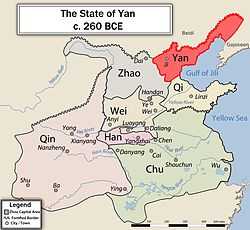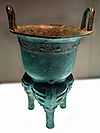Yan (state)
| Yan 燕 | |||||
| |||||
 | |||||
| Capital | Ji | ||||
| Government | Monarchy | ||||
| Historical era | Zhou Dynasty | ||||
| - | Established | 11th century BC | |||
| - | Conquered by Qin | 222 BC | |||
| Currency | knife money spade money other ancient Chinese coinage | ||||

Yan (Chinese: 燕, old *ʻEn,[2] mod. Yān), formerly romanized as Yen, was an ancient Chinese state during the Zhou dynasty.[3][4] Its capital was Ji (later known as Yanjing and now Beijing).[5] During the Warring States period, the court was also moved to another capital at Xiadu at times.[6]
The history of Yan began in the Western Zhou in the early first millennium BC. After the authority of the Zhou king declined during the Spring and Autumn Period in the 8th century BC, Yan survived and became one of the strongest states in China. During the Warring States period from the 5th to 3rd centuries BC, Yan was one of the last states to be conquered by the armies of Qin Shihuang: Yan fell in 222 BC, the year before the declaration of the Qin Empire. Yan experienced a brief period of independence after the collapse of the Qin dynasty in 207 BC, but it was eventually absorbed by the victorious Han.
History
Bronzeware unearthed at the former Yan capital at Liulihe now on display at the Beijing Capital Museum




According to Sima Qian's Records of the Grand Historian, King Wu of Zhou deposed the last Shang king c. 1046 BC and conferred titles to nobles within his domain, including the rulers of the Yan.[7]
In the 11th Century BC, Yan's capital was based in Liulihe Township of Fangshan District of modern day Beijing, where a large walled settlement and over 200 tombs of nobility have been unearthed.[8] Among the most significant artifacts from the Liulihe Site is a bronze ding with inscriptions that recount the journey of the eldest son of the Duke of Yan who delivered offerings to the King of Zhou in present-day Xi'an, and was awarded a position in the king's court.
In the 3rd century BC, the Yellow River followed a more northerly course than the present day. It emptied into the Bohai Sea at a point south of Tianjin in what is now Hebei province as opposed Shandong Province today. Some time during the 7th century BC, in the late Western Zhou or early Eastern Zhou Dynasty, the State of Yan absorbed the State of Ji, a smaller kingdom to the north and moved its capital from Liulihe to that of Ji, in modern-day, Xicheng District of Beijing.
The state of Yan stretched from the Yellow River to the Yalu and from the mountains of Shanxi Province to the Liaodong Peninsula. As the most northeastern of all the Chinese states during this time period, Yan faced incursions from steppe nomads and built Great Walls in southern Liaoning.
To the south, border states Zhao and Qi were Yan's main rivals. The mountainous border in the west between Zhao and Yan became the area in which their armies often clashed. Despite this, the war between Zhao and Yan usually dragged on into a stalemate, requiring the help of other kingdoms to conclude.
In the late 4th century, General Qin Kai invaded and defeated Gojoseon, thus conquering the Liaodong Peninsula.
The strongest opposition came from the Qi, one of the strongest states in China. In 314 BC, taking advantage of a succession crisis within Yan, Qi invaded and in a little over several months practically conquered the country. However, due to the misconduct of Qi troops during the conquest of Yan a revolt eventually drove them away and the borders of Yan were restored. Yan's new king, King Zhao of Yan then plotted with the states of Zhao, Qin, Han and Wei for a joint expedition against Qi. Led by the brilliant tactician Yue Yi, it was highly successful and within a year most of Qi's seventy walled cities had fallen, with the exception of Zimu and Lu. However with the death of King Zhao and the expulsion of Yue Yi to Zhao by the new king, King Wei of Yan, General Tian Shan managed to recapture all of the cities from the 5 kingdoms.
Despite the wars, Yan survived through the Warring States period. In 227 BC, with Qin troops on the border after the collapse of Zhao, the Yan Prince Dan sent an assassin named Jing Ke to kill the king of Qin, later First Emperor of Qin, hoping to end the Qin threat. The mission failed, with Jing Ke dying at the hands of the King of Qin in Xianyang.
Surprised and enraged by such a bold act (one that came terribly close to causing his demise), the king of Qin called on Wang Jian to destroy Yan. Crushing the bulk of the Yan army at the frozen Yishui River, Ji fell the following year and the ruler, King Xi, fled to the Liaodong Peninsula.
In 222 BC, Liaodong fell as well, and Yan was totally conquered by Qin. Yan was the third last state to fall, and with its destruction the fates of the remaining two kingdoms were sealed. In 221 BC, Qin conquered all of China, ending the Warring States period and founding the Qin Dynasty.
Post-Qin interregnum
In 207 BC, the Qin dynasty collapsed and China resumed a state of civil war. King Wu Chen of Zhao eventually sent his General Han Guang to conquer Yan for Zhao, but upon his conquest, Han Guang appointed himself King of Yan. Han Guang had sent his general Zang Tu to assist Xiang Yu, the king of Chu, in his war against Qin. When Zang Tu returned, Han Guang was ordered to become King of Liaodong instead. When Han Guang refused, Zang Tu killed him and declared himself King of both Yan and Liaodong.
Zang Tu submitted Yan to Han during the war between Han and Chu in order to keep his title, but once the war was finished he revolted. Liu Bang sent Fan Kuai and Zhou Bo to put down the rebellion, and they captured and executed Zang Tu.
Lu Wan became the new King of Yan and reigned there for most of Liu Bang's life until he failed to meet a summons to the Imperial Court due to illness. He fled to the Xiongnu to avoid being executed. Yan then came under direct control of the Han Dynasty.
Yan in astronomy
Yan is represented by the star Zeta Capricorni in the "Twelve States" asterism, part of the lunar mansion "Girl" in the "Black Turtle" symbol.[9] Yan is also represented by the star Nu Ophiuchi in the "Left Wall" asterism in the "Heavenly Market" enclosure.[10]
See also
References
- ↑ Wang Jijie (September 1, 2005). "燕国明刀分期研究及相关问题探讨" [Research on Yan Knife-Money and Related Topics]. Beijing Municipal Cultural Office. Retrieved July 26, 2011. (Chinese)
- ↑ Baxter, William & al. "Baxter–Sagart Old Chinese Reconstruction", p. 3. 2011. Accessed 26 Nov 2013.
- ↑ "The History of Yanshan". Yanshan Central Information Office. Beijing Municipal Government. October 18, 2008. Retrieved July 26, 2011. (Chinese)
- ↑ Chen Zhi (September 30, 2010). "從王國維". 学灯 (Confucius 2000) (16). Retrieved July 26, 2011. (Chinese)
- ↑ "Ji, the Capital of the State of Yan". Beijing Municipal Administration of Cultural Heritage. June 16, 2006. Retrieved July 26, 2011.
- ↑ "Site of the Second Capital of State of Yan". The People's Government of Hebei Province. China Daily. December 29, 2009. Retrieved July 26, 2011.
- ↑ 蓟城纪念柱
- ↑ "Liulihe Site". China Culture.
- ↑ Chen Guanzhong; Chen Hui-Hwa (July 4, 2006). "中國古代的星象系統 (65): 女宿天區" [Ancient Chinese astrological system (65)]. Activities of Exhibition and Education in Astronomy (AEEA) 天文教育資訊網. Taiwan: National Museum of Natural Science. Retrieved July 26, 2011. (Chinese)
- ↑ Chen Hui-Hwa (June 23, 2006). "中國古代的星象系統 (54): 天市左垣、市樓" [Ancient Chinese astrological system (54)]. Activities of Exhibition and Education in Astronomy (AEEA) 天文教育資訊網. Taiwan: National Museum of Natural Science. Retrieved July 26, 2011. (Chinese)
External links
- Yan State Capital Relics in Baoding
- Han Dynasty-Political, Social, Cultural, Historical Analysis of China
| ||||||||||||||||||